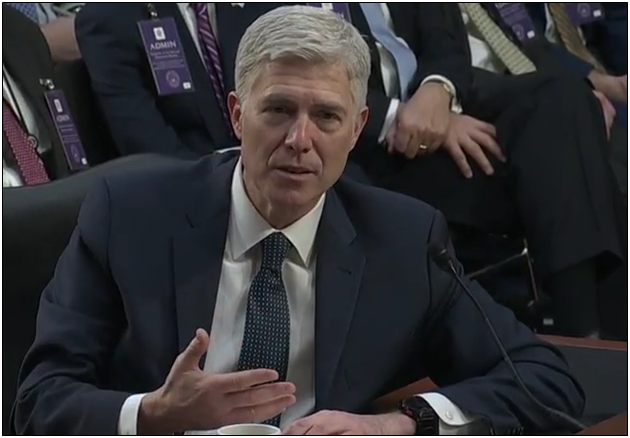By Peter Hong
With over 40 Senate Democrats pledging to hold up the nomination of Judge Neil Gorsuch for the Supreme Court, we are witnessing history: only the second filibuster of a Supreme Court nominee ever (the first was 1968 when Abe Fortas failed the reach cloture in LBJ’s bid to promote him to Chief Justice). Fortunately, this historical anomaly should be short-lived, with a likely move to change Senate rules and allow Gorsuch’s confirmation by a simple majority vote, the so-called “nuclear option.”
According to Majority Leader Mitch McConnell, “Judge Gorsuch will be confirmed this week.”
This sad act of Democrat intransigence has placed the filibuster — and the abuse of this Senate floor procedure — back on the map. First utilized in the Senate in 1837, the filibuster serves to delay or block a floor vote by extending debate on a measure. Senate rules originally required a two-thirds vote of the entire Senate to invoke “cloture,” or end debate on a filibustered bill. The required supermajority was eventually reduced to a three-fifths vote or 60 votes with today’s 100 member Senate.
The filibuster was made famous in real life when Southern Democrats used the tactic to hold up civil rights legislation in the 1950s and 1960s. But it probably gained its greatest lore in movies like Mr. Smith Goes To Washington, where a beleaguered Jimmy Stewart uses the tactic to save federal funding for a national boys’ camp.
Thanks to its glamorization by Hollywood, the filibuster became a symbol of how one person (duly elected or appointed to the U.S. Senate) can change the world (or at least procure public subsidies for the Boy Rangers) simply by staying on one’s feet and talking.
However, the filibuster of today no longer resembles the one most people remember. In 1975, the Senate abolished the requirement that senators hold the floor by speaking, allowing the use of “virtual” filibusters. Not surprisingly, the number of filings for and votes on invoking cloture exploded from only a handful in the sixties to well over a hundred each session in this decade.
There have been some notable exceptions. In 1957, the late Strom Thurmond set the current filibuster record of 24 hours and 18 minutes, standing and speaking against the 1957 civil rights legislation. Before launching his filibuster, Thurmond reportedly spent time in the Senate steam room to drain the fluids out of his body, so he wouldn’t need to use the bathroom. Senate Republican Leader William Knowland accused Thurmond, then a Democrat, of inflicting cruel and unusual punishment on his colleagues.
In this decade of C-SPAN, cable news and the Internet, Senator Rand Paul launched several filibusters lasting over ten hours each to protest the nomination of John Brennan to run the CIA and the National Security Agency’s mass surveillance program. In doing so, the Kentucky senator took advantage of social media, popularizing the Twitter hashtag #standwithrand.
But the vast majority of filibusters go on silently and far from the notice of the voting public. No senator, however, should be allowed to simply inform leadership that he or she has at least 41 votes to block a piece of legislation and slink back into the darkness. With the American people demanding greater transparency from their elected officials, it’s time to bring back the “talking” filibuster rule.
And Republicans should use the “talking” filibuster to hold the Democrats accountable for blocking the change agenda Americans voted for in 2016. One of the critical mistakes the Republican leadership made on Obamacare repeal was to go behind closed door in hopes of developing a “cloture proof” strategy. This led to the disastrous creation of a three-phase monstrosity featuring Ryancare reconciliation (or Phase One), administrative rule changes by HHS (Phase Two), and all the good stuff that actually reduces the cost of health care and might require 60 votes (Phase Three).
Fortunately, the House Freedom Caucus got wise to the fact that Phase Three was like the pot of gold at the end of the rainbow: pure fiction — and jettisoned the bill.
Efforts are underway in Congress to resuscitate the health care effort. If a deal effectively repealing Obamacare in its entirety cannot be reached, the House should simply pass the one-sentence Obamacare repeal bill introduced by Rep. Mo Brooks of Alabama and send it to the Senate. Then, pass the Phase Three legislation that will actually cut health care costs, e.g., tort reform and allowing insurance to be sold across state lines, and send that to the Senate as well. And bring them both to the Senate floor.
Will the Senate Democrats filibuster? You bet they will. Make ‘em stand on the floor and do it. And when they vote against cloture, file again and make every day on the Senate floor seem like “Groundhog Day.” Rinse and repeat.
If the legislative filibuster is going to exist, let the Democrats use it — but don’t let them off easy. Make ‘em talk and talk — and then pay for it in 2018.
Peter Hong is a contributing reporter at Americans for Limited Government.







